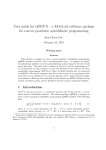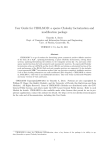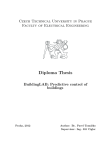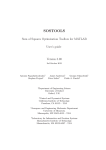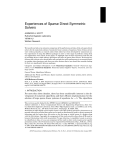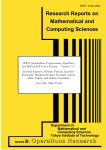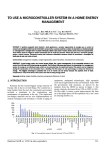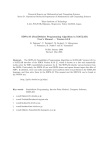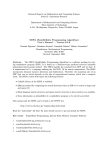Download SMCP Documentation
Transcript
SMCP Documentation
Release 0.3.1
Martin S. Andersen and Lieven Vandenberghe
August 20, 2014
Contents
1
Current release
3
2
Future releases
5
3
Availability
7
4
Authors
9
5
Feedback and bug reports
5.1 Copyright and license . .
5.2 Download and installation
5.3 Documentation . . . . . .
5.4 Test problems . . . . . . .
5.5 Benchmarks . . . . . . .
.
.
.
.
.
.
.
.
.
.
.
.
.
.
.
.
.
.
.
.
.
.
.
.
.
.
.
.
.
.
.
.
.
.
.
.
.
.
.
.
.
.
.
.
.
.
.
.
.
.
.
.
.
.
.
.
.
.
.
.
.
.
.
.
.
.
.
.
.
.
.
.
.
.
.
.
.
.
.
.
.
.
.
.
.
.
.
.
.
.
.
.
.
.
.
.
.
.
.
.
.
.
.
.
.
.
.
.
.
.
.
.
.
.
.
.
.
.
.
.
.
.
.
.
.
.
.
.
.
.
.
.
.
.
.
.
.
.
.
.
.
.
.
.
.
.
.
.
.
.
.
.
.
.
.
.
.
.
.
.
.
.
.
.
.
.
.
.
.
.
.
.
.
.
.
.
.
.
.
.
.
.
.
.
.
.
.
.
.
.
.
.
.
.
.
.
.
.
.
.
11
11
11
11
19
19
i
ii
SMCP Documentation, Release 0.3.1
SMCP is a software package for solving linear sparse matrix cone programs. The code is experimental and it is
released to accompany the following paper:
See also:
13. S. Andersen, J. Dahl, and L. Vandenberghe, Implementation of nonsymmetric interior-point methods for linear
optimization over sparse matrix cones, Mathematical Programming Computation, 2010.
The package provides an implementation of a nonsymmetric interior-point method which is based on chordal matrix
techniques. Only one type of cone is used, but this cone includes the three canonical cones — the nonnegative orthant,
the second-order cone, and the positive semidefinite cone — as special cases. The efficiency of the solver depends not
only on the dimension of the cone, but also on its structure. Nonchordal sparsity patterns are handled using chordal
embedding techniques.
In its current form, SMCP is implemented in Python and C, and it relies on the Python extensions CHOMPACK and
CVXOPT for most computations.
Contents
1
SMCP Documentation, Release 0.3.1
2
Contents
CHAPTER 1
Current release
Version 0.4 (June 16, 2014) includes:
• Nonsymmetric feasible start interior-point methods (primal and dual scaling methods)
• Two KKT system solvers: one solves the symmetric indefinite augmented system and the other solves the
positive definite system of normal equations
• Read/write routines for SDPA sparse data files (‘dat-s’).
• Simple interface to CVXOPT SDP solver
3
SMCP Documentation, Release 0.3.1
4
Chapter 1. Current release
CHAPTER 2
Future releases
We plan to turn SMCP into a C library with Python and Matlab interfaces. Future releases may include additional
functionality as listed below:
• Explicitly handle free variables
• Iterative solver for the KKT system
• Automatic selection of KKT solver and chordal embedding technique
5
SMCP Documentation, Release 0.3.1
6
Chapter 2. Future releases
CHAPTER 3
Availability
The source package is available from the Download and installation section. The source package includes source
code, documentation, and installation guidelines.
7
SMCP Documentation, Release 0.3.1
8
Chapter 3. Availability
CHAPTER 4
Authors
SMCP is developed by Martin S. Andersen and Lieven Vandenberghe .
9
SMCP Documentation, Release 0.3.1
10
Chapter 4. Authors
CHAPTER 5
Feedback and bug reports
We welcome feedback, and bug reports are much appreciated. Please report bugs through our Github repository.
5.1 Copyright and license
Copyright 2009-2014 M. Andersen and L. Vandenberghe.
SMCP is free software; you can redistribute it and/or modify it under the terms of the GNU General Public License as
published by the Free Software Foundation; either version 3 of the License, or (at your option) any later version.
SMCP is distributed in the hope that it will be useful, but WITHOUT ANY WARRANTY; without even the implied
warranty of MERCHANTABILITY or FITNESS FOR A PARTICULAR PURPOSE. See the GNU General Public
License for more details.
5.2 Download and installation
5.2.1 Installation from source
The package requires Python version 2.7 or newer. To build the package from source, the Python header files and
libraries must be installed, as well as the core binaries. SMCP also requires the Python extension modules CVXOPT
1.1.7 or later and CHOMPACK 2.0 or later.
The entire source package is available here, and it includes documentation, installation instructions, and examples.
5.2.2 Installation with pip
SMCP can be installed via pip using the following command:
pip install smcp --user
5.3 Documentation
5.3.1 Overview
Let S𝑛 denote the set of symmetric matrices of order 𝑛, and let and let 𝐶 ∙ 𝑋 denote the standard inner product on S𝑛 .
11
SMCP Documentation, Release 0.3.1
S𝑛𝑉 is the set of symmetric matrices of order 𝑛 and with sparsity pattern 𝑉 , i.e., 𝑋 ∈ S𝑛𝑉 if and only if 𝑋𝑖𝑗 = 0 for
all (𝑖, 𝑗) ̸= 𝑉 . We will assume that all diagonal elements are included in 𝑉 . The projection 𝑌 of 𝑋 on the subspace
S𝑛𝑉 is denoted 𝑌 = 𝑃𝑉 (𝑋), i.e., 𝑌𝑖𝑗 = 𝑋𝑖𝑗 if (𝑖, 𝑗) ∈ 𝑉 and 𝑌𝑖𝑗 = 0 otherwise. The inequality signs ⪰ and ≻ denote
matrix inequality. We define |𝑉 | as the number of nonzeros in the lower triangular part of 𝑉 , and nnz(𝐴𝑖 ) denotes the
number of nonzeros in the matrix A_i.
S𝑛𝑉,+ and S𝑛𝑉,++ are the sets of positive semidefinite and positive definite matrices in S𝑛𝑉 , and similarly, S𝑛𝑉,𝑐+ =
{𝑃𝑉 (𝑋) | 𝑋 ⪰ 0} and S𝑛𝑉,𝑐++ = {𝑃𝑉 (𝑋) | 𝑋 ≻ 0} are the sets of matrices in S𝑛𝑉 that have a positive semidefinite
completion and a positive definite completion, respectively. We denote with ⪰c and ≻c matrix inequality with respect
to the cone S𝑛𝑉,𝑐+ .
SMCP solves a pair of primal and dual linear cone programs:
(𝑃 ) minimize 𝐶 ∙ 𝑋
subject to 𝐴𝑖 ∙ 𝑋 = 𝑏𝑖 , 𝑖 = 1, . . . , 𝑚
𝑋 ⪰c 0
𝑇
(𝐷) maximize 𝑏∑︀
𝑦
𝑚
subject to
𝑖=1 𝑦𝑖 𝐴𝑖 + 𝑆 = 𝐶
𝑆 ⪰ 0.
The variables are 𝑋 ∈ S𝑛𝑉 , 𝑆 ∈ S𝑛𝑉 , and 𝑦 ∈ R𝑚 , and the problem data are the matrix 𝐶 ∈ S𝑛𝑉 , the vector 𝑏 ∈ R𝑚 ,
and 𝐴𝑖 ∈ S𝑛𝑉 , 𝑖 = 1, . . . , 𝑚.
Compositions of cones are handled implicitly by defining a block diagonal sparsity pattern 𝑉 . Dense blocks and
general sparse blocks correspond to standard positive semidefinite matrix constraints, diagonal blocks corresponds to
linear inequality constraints, and second-order cone constraints can be embedded in an LMI with an “arrow pattern”,
i.e,
[︂
]︂
𝑡 𝑥𝑇
‖𝑥‖2 ≤ 𝑡 ⇔
⪰ 0.
𝑥 𝑡𝐼
5.3.2 The chordal SDP solvers
smcp.solvers.chordalsolver_feas(A, b[, primalstart[, dualstart[, scaling=’primal’[, kktsolver=’chol’ ]]]])
Solves the pair of cone programs (P) and (D) using a feasible start interior-point method. If no primal and/or
dual feasible starting point is specified, the algorithm tries to find a feasible starting point based on some simple
heuristics. An exception is raised if no starting point can be found. In this case a Phase I problem must be
solved, or the (experimental) infeasible start interior-point method chordalsolver_esd can be used.
The columns of the sparse matrix A are vectors of length 𝑛2 and the 𝑚 + 1 columns of A are:
[vec(𝐶) vec(𝐴1 ) · · · vec(𝐴𝑚 )] .
Only the rows of A corresponding to the lower triangular elements of the aggregate sparsity pattern 𝑉 are
accessed.
The optional argument primalstart is a dictionary with the key x which can be used to specify an initial value
for the primal variable 𝑋. Similarly, the optional argument dualstart must be a dictionary with keys s and y.
The optional argument scaling takes one of the values ’primal’ (default) or ’dual’.
The optional argument kktsolver is used to specify the KKT solver. Possible values include:
’chol’ (default) solves the KKT system via a Cholesky factorization of the Schur complement
’qr’ solves the KKT system via a QR factorization
The solver returns a dictionary with the following keys:
’primal objective’, ’dual objective’ primal objective value and dual objective value.
’primal infeasibility’, ’dual infeasibility’ residual norms of primal and dual infeasibility.
12
Chapter 5. Feedback and bug reports
SMCP Documentation, Release 0.3.1
’x’, ’s’, and ’y’ primal and dual variables.
’iterations’ number of iterations.
’cputime’, ’time’ total cputime and real time.
’gap’ duality gap.
’relative gap’ relative duality gap.
’status’
• has the value ’optimal’ if
‖𝒜adj (𝑦) + 𝑆 − 𝐶‖𝐹
≤ 𝜖feas ,
max{1, ‖𝐶‖𝐹 }
‖𝑏 − 𝒜(𝑋)‖2
≤ 𝜖feas ,
max{1, ‖𝑏‖2 }
𝑋 ≻c 0,
𝑆 ≻ 0,
and
(︂
𝑋 ∙ 𝑆 ≤ 𝜖abs
or
)︂
𝑋 ∙𝑆
≤ 𝜖rel .
min{𝐶 ∙ 𝑋, −𝑏 𝑦} ≤ 0,
− min{𝐶 ∙ 𝑋, −𝑏𝑇 𝑦}
𝑇
• has the value ’unknown’ otherwise.
The following options can be set using the dictionary smcp.solvers.options:
’delta’ (default: 0.9) a positive constant between 0 and 1; an approximate tangent direction is computed
when the Newton decrement is less than delta.
’eta’ (default: None) None or a positive float. If ’eta’ is a positive number, a step in the approximate
tangent direction is taken such that
Ω(𝑋 + 𝛼∆𝑋, 𝑆 + 𝛼∆𝑆) ≈ 𝜂
where Ω(𝑋, 𝑆) is the proximity function
Ω(𝑋, 𝑆) = 𝜑c (𝑋) + 𝜑(𝑆) + 𝑛 · log
𝑋 ∙𝑆
+ 𝑛.
𝑛
If ’eta’ is None, the step length 𝛼 in the approximate tangent direction is computed as
𝛼𝑝 = arg max{𝛼 ∈ (0, 1] | 𝑋 + 𝛼∆𝑋 ⪰c 0}
𝛼𝑑 = arg max{𝛼 ∈ (0, 1] | 𝑆 + 𝛼∆𝑆 ⪰ 0}
𝛼 = step · min(𝛼𝑝 , 𝛼𝑑 )
where step is the value of the option ’step’ (default: 0.98).
’prediction’ (default: True) True or False. This option is effective only when ’eta’ is None. If
’prediction’ is True, a step in the approximate tangent direction is never taken but only used to
predict the duality gap. If ’prediction’ is False, a step in the approximate tangent direction is
taken.
’step’ (default: 0.98) positive float between 0 and 1.
’lifting’ (default: True) True or False; determines whether or not to apply lifting before taking a step
in the approximate tangent direction.
5.3. Documentation
13
SMCP Documentation, Release 0.3.1
’show_progress’ True or False; turns the output to the screen on or off (default: True).
’maxiters’ maximum number of iterations (default: 100).
’abstol’ absolute accuracy (default: 1e-6).
’reltol’ relative accuracy (default: 1e-6).
’feastol’ tolerance for feasibility conditions (default: 1e-8).
’refinement’ number of iterative refinement steps when solving KKT equations (default: 1).
’cholmod’ use Cholmod’s AMD embedding (defaults: False).
’dimacs’ report DIMACS error measures (default: True).
smcp.solvers.chordalsolver_esd(A, b[, primalstart[, dualstart[, scaling=’primal’[, kktsolver=’chol’ ]]]])
Solves the pair of cone programs (P) and (D) using an extended self-dual embedding. This solver is currently
experimental.
The columns of the sparse matrix A are vectors of length 𝑛2 and the 𝑚 + 1 columns of A are:
[vec(𝐶) vec(𝐴1 ) · · · vec(𝐴𝑚 )] .
Only the rows of A corresponding to the lower triangular elements of the aggregate sparsity pattern 𝑉 are
accessed.
The optional argument primalstart is a dictionary with the key x which can be used to specify an initial value
for the primal variable 𝑋. Similarly, the optional argument dualstart must be a dictionary with keys s and y.
The optional argument scaling takes one of the values ’primal’ (default) or ’dual’.
The optional argument kktsolver is used to specify the KKT solver. Possible values include:
’chol’ (default) solves the KKT system via a Cholesky factorization of the Schur complement
’qr’ solves the KKT system via a QR factorization
The solver returns a dictionary with the following keys:
’primal objective’, ’dual objective’ primal objective value and dual objective value.
’primal infeasibility’, ’dual infeasibility’ residual norms of primal and dual infeasibility.
’x’, ’s’, and ’y’ primal and dual variables.
’iterations’ number of iterations.
’cputime’, ’time’ total cputime and real time.
’gap’ duality gap.
’relative gap’ relative duality gap.
’status’
• has the value ’optimal’ if
(1/𝜏 )‖𝜏 𝑏 − 𝒜(𝑋)‖2
≤ 𝜖feas ,
max{1, ‖𝑏‖2 }
(1/𝜏 )‖𝒜adj (𝑦) + 𝑆 − 𝜏 𝐶‖𝐹
≤ 𝜖feas ,
max{1, ‖𝐶‖𝐹 }
𝑋 ≻c 0,
𝑆 ≻ 0,
and
𝑋 ∙𝑆
≤ 𝜖abs
𝜏2
14
or
(︂
min{𝐶 ∙ 𝑋, −𝑏𝑇 𝑦} ≤ 0,
)︂
(1/𝜏 )𝑋 ∙ 𝑆
≤
𝜖
.
rel
− min{𝐶 ∙ 𝑋, −𝑏𝑇 𝑦}
Chapter 5. Feedback and bug reports
SMCP Documentation, Release 0.3.1
• has the value ’primal infeasible’ if
𝑏𝑇 𝑦 = 1,
‖𝒜adj (𝑦) + 𝑆‖𝐹
≤ 𝜖feas ,
max{1, ‖𝐶‖𝐹 }
𝑆 ≻ 0.
• has the value ’dual infeasible’ if
𝐶 ∙ 𝑋 = −1,
‖𝒜(𝑋)‖2
≤ 𝜖feas ,
max{1, ‖𝑏‖2 }
𝑋 ≻c 0.
• has the value ’unknown’ if maximum number iterations is reached or if a numerical error is encountered.
The following options can be set using the dictionary smcp.solvers.options:
’show_progress’ True or False; turns the output to the screen on or off (default: True).
’maxiters’ maximum number of iterations (default: 100).
’abstol’ absolute accuracy (default: 1e-6).
’reltol’ relative accuracy (default: 1e-6).
’feastol’ tolerance for feasibility conditions (default: 1e-8).
’refinement’ number of iterative refinement steps when solving KKT equations (default: 1).
’cholmod’ use Cholmod’s AMD embedding (defaults: False).
’dimacs’ report DIMACS error measures (default: True).
5.3.3 Solver interfaces
The following functions implement CVXOPT-like interfaces to the experimental solver chordalsolver_esd.
smcp.solvers.conelp(c, G, h[, dims[, kktsolver=’chol’ ]])
Interface to chordalsolver_esd.
smcp.solvers.lp(c, G, h[, kktsolver=’chol’ ])
Interface to conelp; see CVXOPT documentation for more information.
smcp.solvers.socp(c[, Gl, hl[, Gq, hq[, kktsolver=’chol’ ]]])
Interface to conelp; see CVXOPT documentation for more information.
smcp.solvers.sdp(c[, Gl, hl[, Gs, hs[, kktsolver=’chol’ ]]])
Interface to conelp; see CVXOPT documentation for more information.
5.3.4 The SDP object
class SDP(filename)
Class for SDP problems.
chordalsolver_esd.
Simplifies reading and writing SDP data files and includes a wrapper for
The constructor accepts sparse SDPA data files (extension ‘dat-s’) and data files created with the save method
(extension ‘pkl’). Data files compressed with Bzip2 can also be read (extensions ‘dat-s.bz2’ and ‘pkl.bz2’).
m
Number of constraints.
n
Order of semidefinite variable.
5.3. Documentation
15
SMCP Documentation, Release 0.3.1
A
Problem data: sparse matrix of size 𝑛2 × (𝑚 + 1) with columns vec(𝐶), vec(𝐴1 ), . . . , vec(𝐴𝑚 ). Only
the lower triangular elements of 𝐶, 𝐴1 , . . . , 𝐴𝑚 are stored.
b
Problems data: vector of length 𝑚.
V
Sparse matrix with aggregate sparsity pattern (lower triangle).
nnz
Number of nonzero elements in lower triangle of aggregate sparsity pattern.
nnzs
Vector with number of nonzero elements in lower triangle of 𝐴0 , . . . , 𝐴𝑚 .
nzcols
Vector with number of nonzero columns in 𝐴1 , . . . , 𝐴𝑚 .
issparse
True if the number of nonzeros is less than 0.5 · 𝑛(𝑛 + 1)/2, otherwise false.
ischordal
True if aggregate sparsity pattern is chordal, otherwise false.
get_A(i)
Returns the 𝑖‘th coeffiecient matrix 𝐴𝑖 (0 ≤ 𝑖 ≤ 𝑚) as a sparse matrix. Only lower triangular elements are
stored.
write_sdpa([fname[, compress=False ]])
Writes SDP data to SDPA sparse data file. The extension ‘dat-s’ is automatically added to the filename.
The method is an interface to sdpa_write.
If compress is true, the data file is compressed with Bzip2 and ‘bz2’ is appended to the filename.
save([fname[, compress=False ]])
Writes SDP data to file using cPickle. The extension ‘pkl’ is automatically added to the filename.
If compress is true, the data file is compressed with Bzip2 and ‘bz2’ is appended to the filename.
solve_feas([scaling=’primal’[, kktsolver=’chol’[, primalstart[, dualstart ]]]])
Interface to the feasible start solver chordalsolver_feas. Returns dictionary with solution.
solve_phase1([kktsolver=’chol’[, M=1e5 ]])
Solves a Phase I problem to find a feasible (primal) starting point:
minimize 𝑠
subject to 𝐴𝑖 ∙ 𝑋 = 𝑏𝑖 , 𝑖 = 𝑖, . . . , 𝑚
tr(𝑋) ≤ 𝑀
𝑋 + (𝑠 − 𝜖)𝐼 ⪰c 0, 𝑠 ≥ 0
The variables are 𝑋 ∈ S𝑛𝑉 and 𝑠 ∈ R, and 𝜖 ∈ R++ is a small constant. If 𝑠⋆ < 𝜖, the method returns
𝑋 ⋆ (which is a strictly feasible starting point in the original problem) and a dictionary (with information
about the Phase I problem). If 𝑠 >= 𝜖 the method returns (None, None).
solve_esd([scaling=’primal’[, kktsolver=’chol’[, primalstart[, dualstart ]]]])
Interface to chordalsolver_esd. Returns dictionary with solution.
solve_cvxopt([primalstart[, dualstart ]])
Interface to cvxopt.solvers.sdp(). Returns dictionary with solution. (Note that this simple interface does not yet specify block structure properly.)
The following example demostrates how to load and solve a problem from an SDPA sparse data file:
16
Chapter 5. Feedback and bug reports
SMCP Documentation, Release 0.3.1
>>> from smcp import SDP
>>> P = SDP(’qpG11.dat-s’)
>>> print P
<SDP: n=1600, m=800, nnz=3200> qpG11
>>> sol = P.solve_feas(kktsolver=’chol’)
>>> print sol[’primal objective’]
-2448.6588977
>>> print sol[’dual objective’]
-2448.65913565
>>> print sol[’gap’]
0.00023794772363
>>> print sol[’relative gap’]
9.71747121876e-08
5.3.5 Auxiliary routines
smcp.completion(X)
Computes the maximum determinant positive definite completion of a sparse matrix X.
Example:
>>>
>>>
>>>
>>>
from smcp import mtxnorm_SDP, completion
P = mtxnorm_SDP(p=10,q=2,r=10)
sol = P.solve_feas(kktsolver=’chol’)
X = completion(sol[’x’])
smcp.misc.ind2sub(siz, ind)
Converts indices to subscripts.
Parameters
• siz (integer) – matrix order
• ind (matrix) – vector with indices
Returns matrix I with row subscripts and matrix J with column subscripts
smcp.misc.sub2ind(siz, I, J)
Converts subscripts to indices.
Parameters
• siz (integer tuple) – matrix size
• I (matrix) – row subscripts
• J (matrix) – column subscripts
Returns matrix with indices
smcp.misc.sdpa_read(file_obj)
Reads data from sparse SDPA data file (file extension: ‘dat-s’). A description of the sparse SDPA file format
can be found in the document SDPLIB/FORMAT and in the SDPA User’s Manual.
Example:
>>> f = open(’qpG11.dat-s’)
>>> A, b, blockstruct = smcp.misc.sdpa_read(f)
>>> f.close()
5.3. Documentation
17
SMCP Documentation, Release 0.3.1
smcp.misc.sdpa_readhead(file_obj)
Reads header from sparse SDPA data file and returns the order 𝑛, the number of constraints 𝑚, and a vector
with block sizes.
Example:
>>> f = open(’qpG11.dat-s’)
>>> n, m, blockstruct = smcp.misc.sdpa_readhead(f)
>>> f.close()
smcp.misc.sdpa_write(file_obj, A, b, blockstruct)
Writes SDP data to sparse SDPA file.
Example:
>>> f = open(’my_data_file.dat-s’,’w’)
>>> smcp.misc.sdpa_write(f,A,b,blockstruct)
>>> f.close()
5.3.6 Analysis routines
smcp.analysis.embed_SDP(P[, order[, cholmod ]])
Computes chordal embedding and returns SDP object with chordal sparsity pattern.
Parameters
• P (SDP) – SDP object with problem data
• order (string) – ‘AMD’ (default) or ‘METIS’
• cholmod (boolean) – use Cholmod to compute embedding (default is false)
Returns SDP object with chordal sparsity
Note that CVXOPT must be compiled and linked to METIS in order to use the METIS ordering.
The following routines require Matplotlib:
smcp.analysis.spy(P[, i[, file[, scale ]]])
Plots aggregate sparsity pattern of SDP object P or sparsity pattern of 𝐴𝑖 .
Parameters
• P (SDP) – SDP object with problem data
• i (integer) – index between 0 and m
• file (string) – saves plot to file
• scale (float) – downsamples plot
smcp.analysis.clique_hist(P)
Plots clique histogram if P.ischordal is true, and otherwise an exception is raised.
Parameters P (SDP) – SDP object with problem data
smcp.analysis.nnz_hist(P)
Plots histogram of number of nonzeros in lower triangle of 𝐴1 , . . . , 𝐴𝑚 .
Parameters P (SDP) – SDP object with problem data
18
Chapter 5. Feedback and bug reports
SMCP Documentation, Release 0.3.1
5.3.7 Random problem generators
class mtxnorm_SDP(p, q, r[, density[, seed ]])
Inherits from SDP class.
Generates random data 𝐹𝑖 , 𝐺 ∈ R𝑝×𝑞 for the matrix norm minimization problem
minimize ‖𝐹 (𝑧) + 𝐺‖2
with the variable 𝑧 ∈ R𝑟 and where 𝐹 (𝑧) = 𝑧1 𝐹1 + · · · 𝑧𝑟 𝐹𝑟 . The problem is cast as an equivalent SDP:
minimize
subject to
𝑡[︂
]︂
𝑡𝐼
(𝐹 (𝑧) + 𝐺)𝑇
⪰ 0.
𝐹 (𝑧) + 𝐺
𝑡𝐼
The sparsity of 𝐹𝑖 can optionally be chosen by specifying the parameter density which must be a float
between 0 and 1 (default is 1 which corresponds to dense matrices).
Example:
>>> from smcp import mtxnorm_SDP
>>> P = mtxnorm_SDP(p=200,q=10,r=200)
>>> print P
<SDP: n=210, m=201, nnz=2210> mtxnorm_p200_q10_r200
>>> sol = P.solve_feas(kktsolver=’qr’)
class base.band_SDP(n, m, bw[, seed ])
Generates random SDP with band sparsity and m constraints, of order n, and with bandwidth bw (bw=0 corresponds to a diagonal, bw=1 is tridiagonal etc.). Returns SDP object. The optional parameter seed sets the
random number generator seed.
Example:
>>> from smcp import band_SDP
>>> P = band_SDP(n=100,m=100,bw=2,seed=10)
>>> print P
<SDP: n=100, m=100, nnz=297> band_n100_m100_bw2
>>> X,p1sol = P.solve_phase1(kktsolver=’qr’)
>>> P.solve_feas(kktsolver=’qr’,primalstart={’x’:X})
>>> print sol[’primal objective’],sol[’dual objective’]
31.2212701455 31.2212398351
class base.rand_SDP(V, m[, density[, seed ]])
Generates random SDP with sparsity pattern V and m constraints. Returns SDP object.
The sparsity of 𝐴𝑖 can optionally be chosen by specifying the parameter density which must be a float
between 0 and 1 (default is 1 which corresponds to dense matrices).
5.4 Test problems
The SMCP repository contains a number of SDP problem instances that were created with SMCP and have been used
for benchmarks. The files follow the SDPA sparse data format and are compressed with Bzip2.
5.5 Benchmarks
To assess the performance of our preliminary implementation of SMCP, we have conducted a series of numerical
experiments.
5.4. Test problems
19
SMCP Documentation, Release 0.3.1
5.5.1 SDP solvers
The following interior-point solvers were used in our experiments:
• Method M1 (SMCP 0.3a, feasible start solver with kktsolver=’chol’)
• Method M1c (SMCP 0.3a, feasible start solver with kktsolver=’chol’ and solvers.options[’cholmod’]=True)
• Method M2 (SMCP 0.3a, feasible start solver with kktsolver=’qr’)
• CSDP 6.0.1
• DSDP 5.8
• SDPA 7.3.1
• SDPA-C 6.2.1 (binary dist.)
• SDPT3 4.0b (64-bit Matlab)
• SeDuMi 1.2 (64-bit Matlab)
5.5.2 Error measures
We report DIMACS error measures when available. The six error measures are defined as:
‖𝒜(𝑋) − 𝑏‖2
1 + ‖𝑏‖∞
{︂
}︂
−𝜆min (𝑋)
𝜖2 (𝑋, 𝑦, 𝑆) = max 0,
1 + ‖𝑏‖∞
𝜖1 (𝑋, 𝑦, 𝑆) =
‖𝒜adj (𝑦) + 𝑆 − 𝐶‖𝐹
1 + ‖𝐶‖max
{︂
}︂
−𝜆min (𝑆)
𝜖4 (𝑋, 𝑦, 𝑆) = max 0,
1 + ‖𝐶‖max
𝜖3 (𝑋, 𝑦, 𝑆) =
𝐶 ∙ 𝑋 − 𝑏𝑇 𝑦
1 + |𝐶 ∙ 𝑋| + |𝑏𝑇 𝑦|
𝑆∙𝑋
𝜖6 (𝑋, 𝑦, 𝑆) =
1 + |𝐶 ∙ 𝑋| + |𝑏𝑇 𝑦|
𝜖5 (𝑋, 𝑦, 𝑆) =
Here ‖𝐶‖max = max𝑖,𝑗 |𝐶𝑖𝑗 |, and 𝐶 ∙ 𝑋 = tr(𝐶 𝑇 𝑋).
Note that 𝜖2 (𝑋, 𝑦, 𝑆) = 0 and 𝜖4 (𝑋, 𝑦, 𝑆) = 0 since all iterates (𝑋, 𝑦, 𝑆) satisfy 𝑋 ∈ S𝑛𝑉,𝑐++ and 𝑆 ∈ S𝑛𝑉,++ .
5.5.3 Experimental setup
The following experiments were conducted on a desktop computer with an Intel Core 2 Quad Q6600 CPU (2.4 GHz),
4 GB of RAM, and running Ubuntu 9.10 (64 bit).
The problem instances used in the experiments are available for download here and the SDPLIB problems are available
here.
We use the least-norm solution to the set of equations 𝐴𝑖 ∙𝑋, 𝑖 = 1, . . . , 𝑚, as starting point when it is strictly feasible,
and otherwise we solve the phase I problem
minimize 𝑠
subject to 𝐴𝑖 ∙ 𝑋 = 𝑏𝑖 , 𝑖 = 1, . . . , 𝑚,
tr(𝑋) ≤ 𝑀
𝑋 + (𝑠 − 𝜖)𝐼 ⪰c 0, 𝑠 ≥ 0.
20
Chapter 5. Feedback and bug reports
SMCP Documentation, Release 0.3.1
Here 𝜖 is a small constant, and the constraint tr(𝑋) ≤ 𝑀 is added to bound the feasible set.
5.5.4 SDPs with band structure
We consider a family of SDP instances where the data matrices 𝐶, 𝐴1 , . . . , 𝐴𝑚 are of order 𝑛 and banded with a
common bandwidth 2𝑤 + 1.
Experiment 1
𝑚 = 100 constraints, bandwidth 11 (𝑤 = 5), and variable order 𝑛
Experiment 2
order 𝑛 = 500, bandwidth 7 (𝑤 = 3), and variable number of constraints 𝑚
The problem band_n500_m800_w3 required a phase I (M1 311.5 sec.; M2 47.8 sec.).
Experiment 3
order 𝑛 = 200, 𝑚 = 100 constraints, and variable bandwidth 2𝑤 + 1
Two problems required a phase I: band_n200_m100_w0 (M1 1.12 sec.; M2 0.53 sec.) and band_n200_m100_w1 (M1
3.18 sec.; M2 1.45 sec.).
5.5.5 Matrix norm minimization
We consider the matrix norm minimization problem
minimize ‖𝐹 (𝑥) + 𝐺‖2
where 𝐹 (𝑥) = 𝑥1 𝐹1 + · · · + 𝑥𝑟 𝐹𝑟 and 𝐺, 𝐹𝑖 ∈ R𝑝×𝑞 are the problem data. The problem can be formulated as an
SDP:
minimize
subject to
𝑡[︂
𝑡𝐼
(𝐹 (𝑥) + 𝐺)𝑇
]︂
𝐹 (𝑥) + 𝐺
⪰ 0.
𝑡𝐼
This SDP has dimensions 𝑚 = 𝑟 + 1 and 𝑛 = 𝑝 + 𝑞. We generate 𝐺 as a dense 𝑝 × 𝑞 matrix, and the matrices 𝐹𝑖
are generated such that the number of nonzero entries in each matrix is given by max(1, 𝑑𝑝𝑞) where the parameter
𝑑 ∈ [0, 1] determines sparsity. The locations of nonzero entries in 𝐹𝑖 are random. Thus, the problem family is
parameterized by the tuple (𝑝, 𝑞, 𝑟, 𝑑).
Experiment 4
variable number of rows 𝑝, 𝑞 = 10 columns, 𝑟 = 100 variables, and density 𝑑 = 1
Experiment 5
𝑝 = 400 rows, 𝑞 = 10 columns, 𝑟 = 200 variables, and variable density
5.5. Benchmarks
21
SMCP Documentation, Release 0.3.1
Experiment 6:
𝑝 = 400 rows, 𝑞 = 10 columns, variable number of variables 𝑟, and density 𝑑 = 1
Experiment 7:
𝑝 + 𝑞 = 1000, 𝑟 = 10 variables, and density 𝑑 = 1
5.5.6 Overlapping cliqes
We consider a family of SDPs which have an aggregate sparsity patterns 𝑉 with 𝑙 cliques of order 𝑁 . The cliques are
given by
𝑊𝑖 = {(𝑖 − 1)(𝑁 − 𝑢) + 1, . . . , (𝑖 − 1)(𝑁 − 𝑢) + 1 + 𝑢},
𝑖 = 1, . . . , 𝑙
where 𝑢 (0 ≤ 𝑢 ≤ 𝑁 − 1) is the overlap between neighboring cliques. The sparsity pattern is illustrated below:
Note that 𝑢 = 0 corresponds to a block diagonal sparsity pattern and 𝑢 = 𝑁 − 1 corresponds to a band pattern.
Experiment 8
𝑚 = 100 constraints, clique size 𝑁 = 16, and variable overlap 𝑢
5.5.7 SDPLIB problems
The following experiment is based on problem instances from .
22
Chapter 5. Feedback and bug reports
SMCP Documentation, Release 0.3.1
Experiment 9
SDPLIB problems with 𝑛 ≥ 500
Three problems required a phase I: thetaG11 (M1 227.2 sec.; M1c 184.4 sec.), thetaG51 (M1 64.8 sec.: M1c 58.0
sec.), and truss8 (M1 17.9 sec.; M1c 17.9 sec.).
5.5.8 Nonchordal sparsity patterns
The following problems are based on sparsity patterns from the University of Florida Sparse Matrix Collection
(UFSMC). We use as problem identifier the name rsX where X is the ID number of a sparsity pattern from
UFSMC. Each problem instance has 𝑚 constraints and the number of nonzeros in the lower triangle of 𝐴𝑖 is
max{1, round(0.005|𝑉 |)} where |𝑉 | is the number of nonzeros in the lower triangle of the aggregate sparsity pattern
𝑉 , and 𝐶 has |𝑉 | nonzeros.
Experiment 10
5.5. Benchmarks
23




























